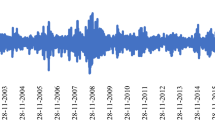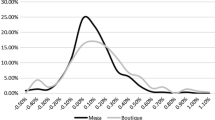Abstract
This study investigates the effects of size on the risk-adjusted fund performance of US-publicly listed index-tracking passive equity exchange-traded funds (ETFs). Using panel quantile and Fama–MacBeth cross-sectional regression approaches, we determine that the asset-based size growth is informative in the risk-return trade-offs of ETFs, and that these ETFs do not follow a constant return-to-scale. The quantile regression results show that the rate of return-to-scale diminishes as the ETFs size increases and becomes negative for the most significant fund group. The size has a considerably substantial negative impact on the highest-performing clusters of ETFs, suggesting that the diseconomies of scale found in conventional active mutual funds affect the ETFs. The results align with Indro et al. (Financ Anal J 55: 74–87, 1999) findings of mutual funds that there are diminishing marginal returns to information acquisition and trading, and the marginal returns become negative when the fund exceeds its optimal size. This study provides further insights and understanding of the performance and size relationship of index-tracking passive equity ETFs.

Similar content being viewed by others
Notes
According to the center for research in security prices (CRSP) manual, index-tracking funds are identified as the CRSP index fund flag (funds with a value of “D”) that corresponds to “Pure Index Funds.” The study includes equity ETFs and mentions that the difference between traditional index-tracking funds and ETFs are small because both represent traded passive portfolios.
And it can uncover the role of fund attributes, such as number of holdings, fund age, lagged fund flow, lagged fund return, lagged fund size, investment styles, and fund types, in the size–performance relationship. Refer to Yan (2008) for further discussions on the role of investment factors and fund attributes on the size–performance relationship.
Refer to Koenker and Bassett (1978) for the technical aspects of estimating a QR model.
Koenker and Hallock (2001) discuss the properties and usefulness of the Quantile Regressions.
As VIX is a single time series variable, when using the Fama and MacBeth cross-sectional regression, it suppresses constant. Therefore, we replace VIX with historical volatility measured by historical standard deviation.
Chen et al. (2004) suggests using different benchmark models to mitigate fund size and style heterogeneity issues that may cause abnormal returns.
These factors and the risk-free rate are obtained from a Kenneth French’s website: http://mba.tuck.dartmouth.edu/pages/faculty/ken.french/data_library.html
The empirical results based on CAPM alpha are the same and are not reported.
References
Ben-David, Itzhak, Francesco Franzoni, and Rabih Moussawi. 2018. Do ETFs increase volatility?. The Journal of Finance 73 (6): 2471–2535.
Berk, Jonathan B., and Richard C. Green. 2004. Mutual fund flows and performance in rational markets. Journal of Political Economy 112 (6): 1269–1295.
Brinson, G.P., L.R. Hood, and G.L. Beebower. 1986. Determinants of portfolio performance. Financial Analysts Journal 42 (4): 39–44.
Carhart, Mark M. 1997. On persistence in mutual fund performance. The Journal of Finance 52 (1): 57–82.
Chen, Carl R., and Ying Huang. 2011. Mutual fund governance and performance: A quantile regression analysis of Morningstar’s Stewardship Grade. Corporate Governance: an International Review 19 (4): 311–333.
Chen, Joseph, Harrison Hong, Ming Huang, and Jeffrey D. Kubik. 2004. Does fund size erode mutual fund performance? The role of liquidity and organization. American Economic Review 94 (5): 1276–1302.
Chordia, Tarun, Richard Roll, and Avanidhar Subrahmanyam. 2002. Order imbalance, liquidity, and market returns. Journal of Financial Economics 65 (1): 111–130.
Coval, Joshua, and Erik Stafford. 2007. Asset fire sales (and purchases) in equity markets. Journal of Financial Economics 86 (2): 479–512.
Crane, Alan D., and Kevin Crotty. 2018. Passive versus active fund performance: Do index funds have skill?. Journal of Financial and Quantitative Analysis 53 (1): 33–64.
Elton, Edwin J., Martin J. Gruber, and Christopher R. Blake. 2012. Does mutual fund size matter? The relationship between size and performance. The Review of Asset Pricing Studies 2 (1): 31–55.
Fama, Eugene F., and Kenneth R. French. 2010. Luck versus skill in the cross-section of mutual fund returns. Journal of Finance 65 (5): 1915–1947.
Fama, Eugene F., and James D. MacBeth. 1973. Risk, return, and equilibrium: Empirical tests. Journal of Political Economy 81 (3): 607–636.
Frino, Alex, David R. Gallagher, Albert S. Neubert, and Teddy N. Oetomo. 2004. Index design and implications for index tracking. The Journal of Portfolio Management 30 (2): 89–95.
Gao, Xiaohui, and Miles Livingston. 2008. The components of mutual fund fees. Financial Markets, Institutions & Instruments 17 (3): 197–223.
Grinblatt, Mark, and Sheridan Titman. 1989. Portfolio performance evaluation: Old issues and new insights. The Review of Financial Studies 2 (3): 393–421.
Hameed, Allaudeen, Wenjin Kang, and Shivesh Viswanathan. 2010. Stock market declines and liquidity. The Journal of Finance 65 (1): 257–293.
Ibbotson, R.G., and P.D. Kaplan. 2000. Does asset allocation policy explain 40, 90, or 100 percent of performance?. Financial Analysts Journal 56 (1): 26–33.
Indro, Daniel C., Christine X. Jiang, Michael Y. Hu, and Wayne Y. Lee. 1999. Mutual fund performance: Does fund size matter?. Financial Analysts Journal 55 (3): 74–87.
Keim, Donald B. 1999. An analysis of mutual fund design: the case of investing in small-cap stocks. Journal of Financial Economics 51 (2): 173–194.
Koenker, Roger, and Gilbert Bassett Jr. "Regression quantiles." Econometrica (1978): 33-50.
Koenker, Roger, and Kevin F. Hallock. 2001. Quantile regression. Journal of Economic Perspectives 15 (4): 143–156.
Naka, Atsuyuki, and Abdullah Noman. 2017. Diversification of risk exposure through country mutual funds under alternative investment opportunities. The Quarterly Review of Economics and Finance 64: 215–227.
Pástor, Ľuboš, Robert F. Stambaugh, and Lucian A. Taylor. 2015. Scale and skill in active management. Journal of Financial Economics 116 (1): 23–45.
Pástor, Ľuboš, Robert F. Stambaugh, and Lucian A. Taylor. 2020. Fund tradeoffs. Journal of Financial Economics 138 (3): 614–634.
Perold, André F., and Robert S. Salomon. 1991. The right amount of assets under management. Financial Analysts Journal 47 (3): 31–39.
Petajisto, Antti. 2013. Active share and mutual fund performance. Financial Analysts Journal 69 (4): 73–93.
Phillips, B., K. Pukthuanthong, and P.R. Rau. 2018. Size does not matter: Diseconomies of scale in the mutual fund industry revisited. Journal of Banking & Finance 88: 357–365.
Reuter, Jonathan, and Eric Zitzewitz. 2021. How much does size erode mutual fund performance? A regression discontinuity approach. Review of Finance 25 (5): 1395–1432.
Tchamyou, Vanessa S., and Simplice A. Asongu. 2017. Conditional market timing in the mutual fund industry. Research in International Business and Finance 42: 1355–1366.
Yan, Xuemin Sterling. 2008. Liquidity, investment style, and the relation between fund size and fund performance. Journal of Financial and Quantitative Analysis 43 (3): 741–767.
Zhu, Min. 2018. Informative fund size, managerial skill, and investor rationality. Journal of Financial Economics 130 (1): 114–134.
Acknowledgments
None.
Author information
Authors and Affiliations
Corresponding author
Ethics declarations
Competing interests
There are no conflicts of interest to declare.
Additional information
Publisher's Note
Springer Nature remains neutral with regard to jurisdictional claims in published maps and institutional affiliations.
Appendix
Rights and permissions
Springer Nature or its licensor (e.g. a society or other partner) holds exclusive rights to this article under a publishing agreement with the author(s) or other rightsholder(s); author self-archiving of the accepted manuscript version of this article is solely governed by the terms of such publishing agreement and applicable law.
About this article
Cite this article
Paudel, K., Naka, A. Effects of size on the exchange-traded funds performance. J Asset Manag 24, 474–484 (2023). https://doi.org/10.1057/s41260-023-00321-4
Revised:
Accepted:
Published:
Issue Date:
DOI: https://doi.org/10.1057/s41260-023-00321-4
Keywords
- Exchange-traded funds
- Panel quantile regression
- Index-tracking funds
- Asset size
- Scale economies
- Risk-adjusted alpha




